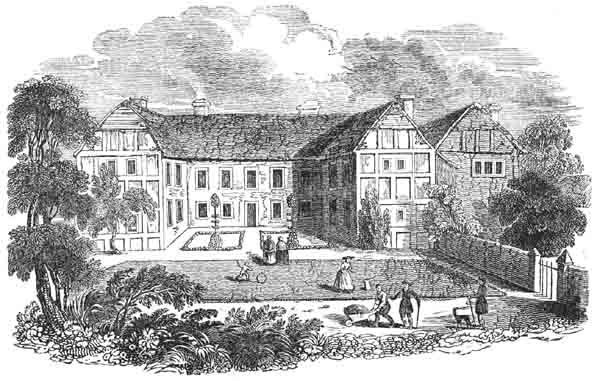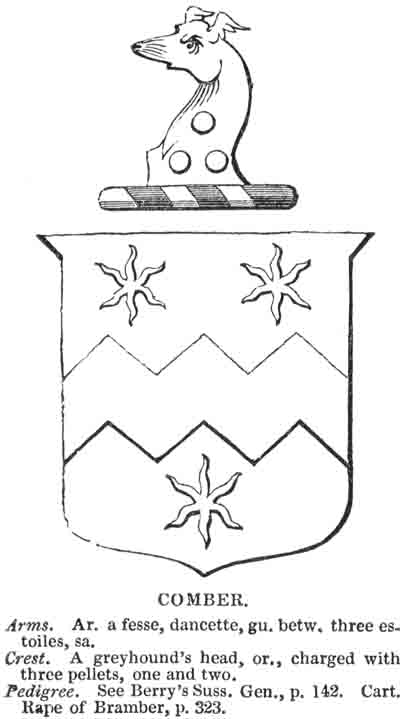From History Of Sussex 2 by Horsefield 1835
HUNDRED OF WINDHAM AND EWHURST.
This Hundred also lies on the eastern side of the Rape, and contains the
parishes of Shermanbury and Cowfold. It has for its boundaries, the Rape of
Lewes on the east, the Hundred of Tipnoak on the south, the Hundreds of West
Grinstead and Singlecross on the west, and the upper part of the Hundred of
Fishersgate on the north ; and has, within these boundaries, 5,720 acres.
SHERMANBURY.
The extent of this parish is somewhat more than 2,000 1 acres,
nearly two-thirds of which are arable and pasture. On the east and south it is
bounded by Woodmancote and Henfield, by West Grinstead on the west, and by
Cowfold on the north. The surface is generally flat ; and the soil being
favourable for the production of wood, fine timber is grown. The population, in
1831, was 345.
The turnpike road from Brighton to Horsham, with a branch road to the west,
intersects the district ; whilst a branch of the Adur fertilizes the southern
boundary. It is navigable hither from Shoreham. The springs are strongly
impregnated with iron, and there are some of a saline quality.
The village church is within Shermanbury Park, in the south-east division of
the parish, and near the banks of the rivulet just mentioned; seven and a half
miles north-east by north from Steyning, nine from Horsham, and forty-three from
London.
The principal proprietors of estates are, the Rev. John Gratwick Challen, D.D.,
Sir Timothy Shelley, Bart., and Mr. Faulconer.
The manor of Salmonesberie is surveyed in Doomsday with the hundred
of Hamfelt. It was held of William de Braose, by Ralph. It was formerly part
of the estate of Earl Harold, when it was assessed at two hides; on its
transference at the Conquest, it ceased to be rated at all. There was a small
church on the manor, and four serfs. The arable required two ploughs. It was
valued at 24s.2
At a very early period of the Norman sway, this small manor was
possessed by the family of Bucy, who have left their name attached to another
of their manors, Kingston Bowsey or Bucy. In the fourteenth century, the manor
passed by an agreement between the sons-in-law of Sir Hugh de Bucy, to Sir
William de Fyfhide. The Earl of Nottingham held it as of his castle of Brembre,
in 1387. From the families of Comber, Gratwick Lintot, and Farncombe, it
descended to John Challen, Esq., the father of the present proprietor, the
Rev. John Gratwick Challen, D.D.3
Dr. Challen is also the proprietor of the manor of Ewhurst,
extending into the adjoining parishes of Henfield and Cowfold, and containing
305 acres of demesne land.
The manors of Morleia and Sacheham, within this parish, are
described in Doomsday. The former, Morley, is now the property of Sir Timothy
Shelley ; the latter, Sakeham, of Mr. Faulconer.
Shermanbury Place, was erected by the late John Challen, Esq., upon the scite
of an ancient edifice of considerable dimensions, with projecting wings, of the
time of Elizabeth. It was in all probability built by one of the family of
Comber ; from which family it descended to the Gratwicks, by the marriage of
Thomas Gratwick, Esq., with Elizabeth, daughter and heiress of William Comber.
We give a sketch of the old mansion; and, through the liberality of Dr.
Challen, an engraving of the new one.

Of the Comber family, there were two eminent divines of the Church of
England; Dr. Thomas Comber, Dean of Carlisle; and Dr. John Comber, Dean of
Durham.4 Of the former, grandfather of the latter, we extract the
following sketch:-
"Doctor Thomas Comber, a man of considerable celebrity in his
time, was born about the end of the sixteenth century, at Shermanbury, in this
county, the twelfth child of Sir Richard Comber, Clarencieux King at Arms. He
laid the foundation of his knowledge in the learned languages, for which he
was afterwards so eminent, at Horsham ; from whence he went to Trinity
College, Cambridge, where he was recommended to the patronage of Doctor
Neville ; by whose interest, and his own reputation as an accomplished
grammarian., he was elected master of that college. Being a person of great
application, unwearied perseverance, and blessed with an excellent memory, he
made himself master of the Greek and Latin languages in an eminent degree, and
understood several of the Oriental. He travelled into Italy, Spain, and
France, where he was denominated by the literati there 'Vir clarissimus,
Thomas Comber, Anglus.' On his return from his travels, about the year 1623,
he was appointed the King's chaplain, on the recommendation of the Archbishop
Abbot ; and soon after to the deanery of Carlisle, on the promotion of Doctor
White to the bishopric of that see; and in the year 1631, was chosen
vice-chancellor of Cambridge. On the breaking out of the civil war in England,
he attached himself warmly to the royal cause, and endeavoured with all his
might to prevail with the other heads of the university to send their plate to
his Majesty, whose finances then were in a very low condition. As the doctor's
endeavours to aid his royal master were discovered, by some means, to the
parliament, in return, they determined to make him feel the weight of their
re-venge. They not only stripped him of his all, consisting of his deanery,
mastership, and the valuable rectory of Worplesdon, in Surrey, but imprisoned
him, A.D. 1642. This hard reverse of fortune, and all the indignities and
severities which the Puritans, and afterwards the Independants, could heap
upon him, he bore with becoming resignation and exemplary fortitude ; till
death, on the 28th of February, 1553, delivered him from the malice and
cruelty of his persecutors."1

Click for larger image
A little west of Shermanbury Place stood the ancient mansion of Ewhurst.
" A small enclosure, surrounded by a circular moat, includes
the scite of the old mansion house, of which there are no remains, except one
chimney. A detached entrance is still standing. It consists of an arched
gateway with a groined ceiling, over which is a tower with a high pointed
roof. On each side are the porters' lodges, built of ragstone and sandstone.
The ancient massy gates, with a small wicket, are still remaining. The style
of the building refers it to the time of Edward I., when it was the residence
of Thomas Peverel."6
The abbey lands belonging to the prebend of Wyndham are chiefly in this
parish.
The living is a rectory in the archdeaconry and deanery of Lewes, valued in
the king's books at 4l, 19s. 4½d. The Rev. John Gratwick
Challen, D. D., is patron and incumbent, to whom belong the great and small
tithes of the whole parish. Glebe sixteen acres.
The church, dedicated to St. Giles, is a small building, consisting of a nave
with very deep roof, on which is perched, at the west end, a small pointed
spire. The ancient lancet windows have been converted into square ones, and
filled with modern painted glass.
Mural monuments are preserved for individuals of the families of Lintot and
Challen, as also one for John Bear, above fifty years rector.
The font is curious, of the age of Henry III.
Miles Williams, in 1786, left by will 5l. to the poor, which was distributed.
Ann Lintott, in 1738, bequeathed 2l. per annum, to be applied to the poor, after
paying for cleaning and repairing Mr. Gratwick's grave. It appears that no
property is charged with this payment, the real estate being entailed.
The registers commence in 1653.
1 According to the Parliamentary Returns, 1,080.
2 Doomsday, 28, h l,
3 West. Suss. Vol. III. p.322.
4 Ib. p. 324.
5 Hay's Chichester, p. 510.
6 West. Suss. Vol. III. p.325.
